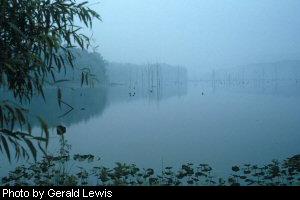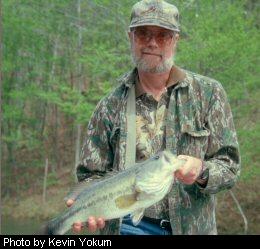

When It Comes To Trophy Bass, Sleepy Creek is Not A SleeperBy Gerald Lewis
Several factors have contributed to the trophy bass potential at this lake. During its early years, reaching the lake meant a long drive over dirt roads which were often in poor condition. These roads were so bad that anglers trying to reach the lake with a boat trailer jokingly asked when we were going to stock fish in the numerous large potholes that were filled with water. Even now, with improved roads, the shortest access to the lake involves a five-mile drive on a dirt road. A damaged water outlet structure required draining the lake in 1970. Refilled and restocked in 1971, the lake soon began producing trophy largemouth bass. Initial records of the Trophy Fish Citation Program established by the Division of Natural Resources Wildlife Resources Section in 1976 contained many entries of largemouth caught in Sleepy Creek. Further damage to the outlet structure necessitated that the lake be drained a second time in 1982. During this second draining, 60 largemouth bass exceeding five pounds were recovered. The lake was refilled in 1985 and DNR personnel stocked it with fingerling largemouth. Sleepy Creek was one of the first lakes, if not the first, in West Virginia where a large volume of standing timber was retained during construction. Approximately 40 percent of the lake initially contained standing timber. Not only did this inundated timber provide terrific fish cover, it made angling more challenging because many of the trees had decayed and fallen below the water surface. Another factor that has enhanced the trophy bass potential is the current management activity of practicing a fall and winter drawdown . During the second draining, the contractor replaced the bottom drain gate on the structure. The old gate was then installed in the upper part of the concrete outlet tower as an auxiliary gate. This allowed the lake level to be dropped five feet without using the bottom drain gate. Since 1990, the lake has been lowered five feet each fall, beginning in September and running through November. Depending on precipitation, the normal lake level may not be reached until February or March. This period of low water level allows predator fish, such as largemouth and northern pike, better access to the smaller sunfish which are more vulnerable once they leave the protective cover of the shallow water vegetation.
Probably the strongest evidence of the outstanding trophy bass potential of Sleepy Creek Lake is the fact that it has led the state in the number of five-pound plus largemouth registered every year from 1994 through 2002. In that nine-year period, Sleepy Creek yielded 129 trophy largemouth. The next best lake was Burnsville Lake with 46 trophy largemouth bass. Plum Orchard Lake in Fayette County, similar in size to Sleepy Creek, had 27 trophy largemouth registered in the same nine-year period. If we express the number of trophy bass registered in other terms, we begin to realize the outstanding nature of this fishery. At Sleepy Creek, the 129 trophy largemouth registered in nine years means an average of slightly more than 14 per year. At Plum Orchard Lake, the 27 trophy bass registered in the same nine years means an average of three per year. At Burnsville Lake, the 46 trophy bass registered in nine years means an average of five per year. How long Sleepy Creek Lake can continue to produce more trophy citation bass than any other state lake is anyone's guess. Just the fact that it has been the top producer for the last nine years makes it special. Under current management practices, it may well continue to produce trophy bass for years to come. Gerald Lewis is a district fisheries biologist stationed in Romney . |
 Nestled between two mountains within the Sleepy Creek Wildlife Management Area in Berkeley County lies West Virginia's top producer of trophy citation largemouth bass during the past decade. Sleepy Creek Lake is anything but sleepy when it comes to producing five-pound bass. No other lake in the state, regardless of size, has come close to equaling the number of citation bass yielded by this unique 205-acre lake built in 1962.
Nestled between two mountains within the Sleepy Creek Wildlife Management Area in Berkeley County lies West Virginia's top producer of trophy citation largemouth bass during the past decade. Sleepy Creek Lake is anything but sleepy when it comes to producing five-pound bass. No other lake in the state, regardless of size, has come close to equaling the number of citation bass yielded by this unique 205-acre lake built in 1962.  In 1979, a new West Virginia weight record for largemouth bass was established at Sleepy Creek Lake when the late William Wilhelm landed a 10.8-pound fish. That record stood until 1994 when an angler caught a 12.28-pound bass from a private pond in Grant County. Another near-record largemouth was caught at Sleepy Creek Lake in February in 1996 when an angler fishing through the ice hooked a 12.24-pound bass.
In 1979, a new West Virginia weight record for largemouth bass was established at Sleepy Creek Lake when the late William Wilhelm landed a 10.8-pound fish. That record stood until 1994 when an angler caught a 12.28-pound bass from a private pond in Grant County. Another near-record largemouth was caught at Sleepy Creek Lake in February in 1996 when an angler fishing through the ice hooked a 12.24-pound bass.